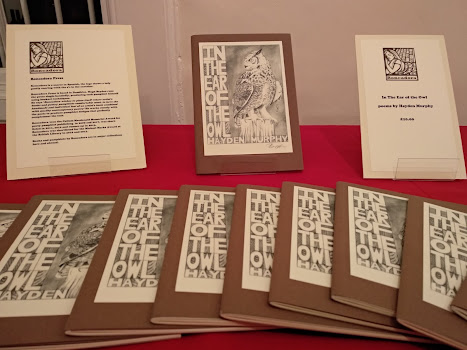New Poems
2.
In the ages of Owls his companions
Were the bipeds with hands. No beak,
No plumage, round shaped feet, no talons,
No hunting skills,
No talent
Apart from words.
Ancestor Owl learnt from Cousin Kestrel
To understand, to calibrate the edge
That borders celebration in their gift of tongues.
That which they call laughter. It was more acceptable
(at first) to what in their rondo of sounds
They called music.
Time passes and alters all, even in the ages of Owl.
Now in the womb of thought lies the heart
Of silence
Awaiting the birth
Of the music that is shared laughter.
In the ear of the Owl
Humans have nothing else worth hearing.
3.
Owl’s companion in a Limerick garden
Was a boy child, a biped with small hands and pink skin.
Usually in the company of a she-mother, addressed as
“Grand”. Black plumed with a tight fitting white skullcap.
A fur covered four legged creature called Cat
Sat guard between them
The black-plumed biped guided the boy-child
To feed me with white coloured liquid that congealed
Into sour-tasting water when the rains came.
The black-cowled one would later give me a wood-plate
Of mouse, held down by a metal bar that sometimes
Had yellow-mould lumps that tasted of both
Sour-water and the presence of Cat.
4.
My broken wing in winter
Was home to spiders,
Held together by strong cobweb.
In summer bees brought in their honey
To weld the feathers to the bone.
In autumn i melted sugar and spider
On the castle of sand and stone
The boy-child built for me and slept.
Later, when we were alone, the she-mother
Would lift me, place me on soft grasses
That smelt of mouse.
Though also at times the bitter taste of Cat.
This became the comfort of Spring.
There was a second and third Spring.
Then I died.
12.
Bloomsday Owl is unheard
In the Joyce book.
Unseen by the academics.
But exists
As
Dignam’s lost descant,
Descartes before the hearse,
Owl speak: Quaquaquaquaqua.
Bloomsday Owl is a figure
Of frenzy in Buchner’s Wozzeck.
In Schubert’s symphony. It has flight
In common. An unfinished element
So
His presence is unseen.
If the eyes had not been done with
Gloucester would have glimpsed
Him
Doing the nighttime shuffle
With Godot.
For Barry Mc Govern
13.
Nor is there an Owl in Yeats’s Purgatory.
Only the burn out presence of another
In a designated Limbo.
Owls have more respect for the eyes
Of the soul than to allow them
No place in the heart.
Silly are the bipeds with hands
Who do not use them to hug together
The feathers of those who have known
How to fly
but no longer need to
In case they elide with the sun
And blot out the moon.
Owl is, with ancestor Icarus, knowing
Now is the time to “Appease
The misery of the living and the remorse
Of the dead.”
22.
Hokusai, at sunbreak, drew an image of a lion.
Threw it into the air. To roam. To cleanse the day.
Unknown to most Basho reincarnated as Owl
Riding on the back of that lion.
Swoop and swallow the wind
Was his advice.
Swallow the air, become a marbled image.
Hide it beneath feathers.
So when night fell
It became a cairn of stars.
As the lion tells it
That is the Owl smile.
24.
In the ear of the Owl
I whisper a prayer. Please
Allow your silence be mine.
No reconstructions. No interruptions
Of the dark by excuses for a past
That did not have time
For prayer.
Fluff up the wings Owl
The future looks cold.
No more I cannot speak
With him. So, I talk to him.
In the ear of the Owl
I place a prayer.
* * *
These poems are taken from In the Ear of the Owl by Hayden Murphy (Roncadora Press, 14 Corberry Avenue, Dumfries DG2 7QQ).
















